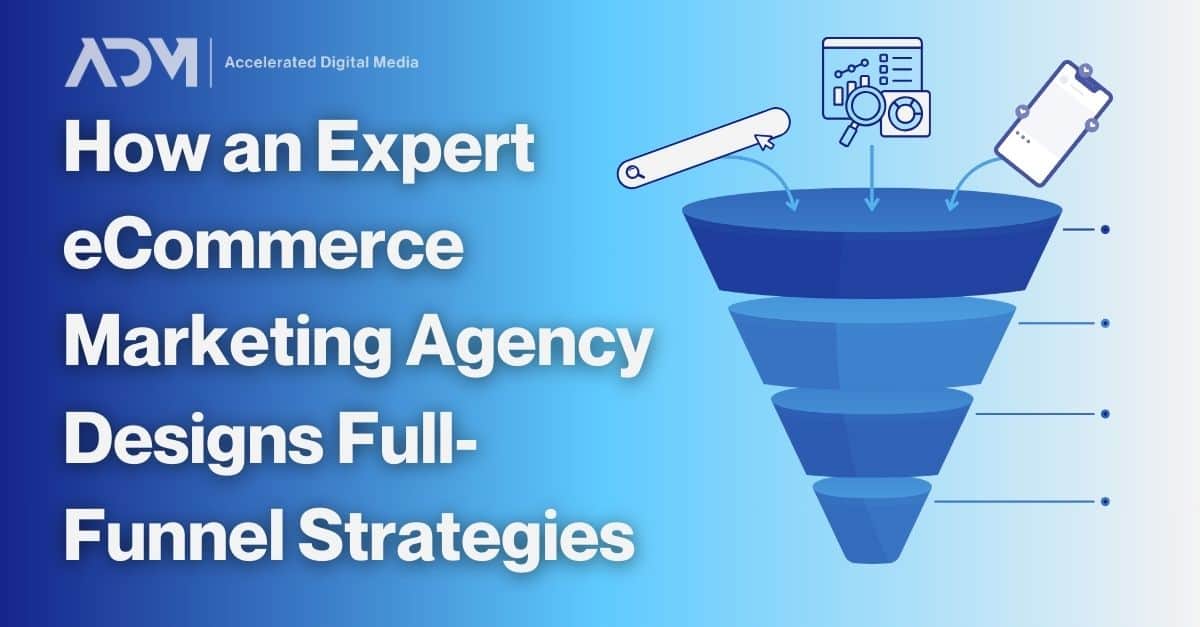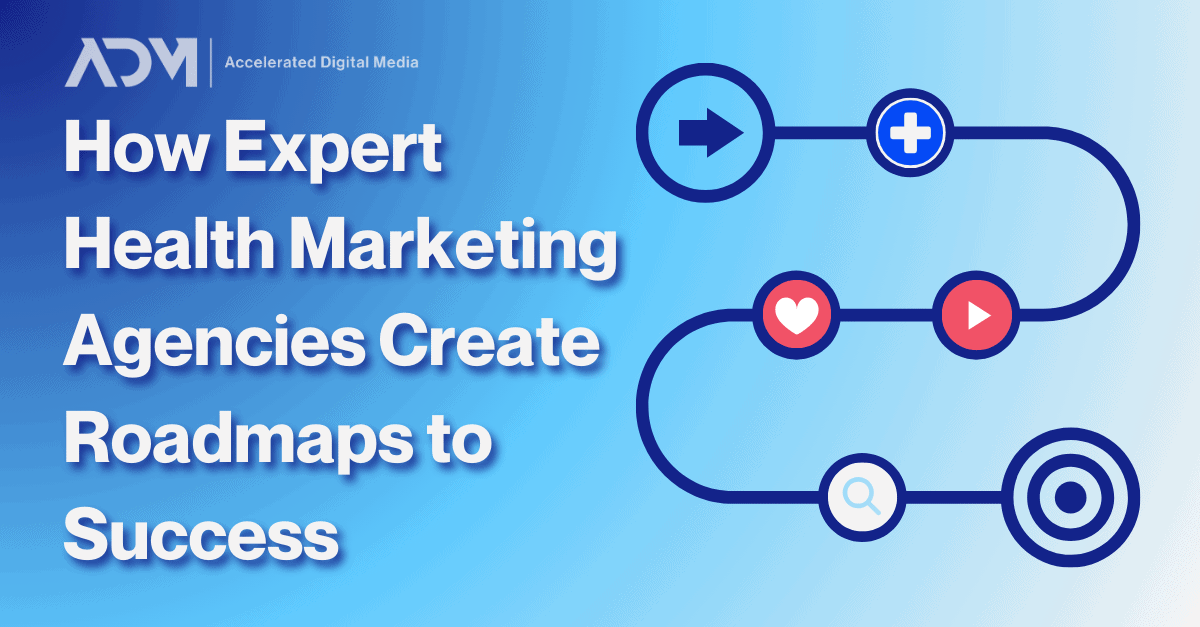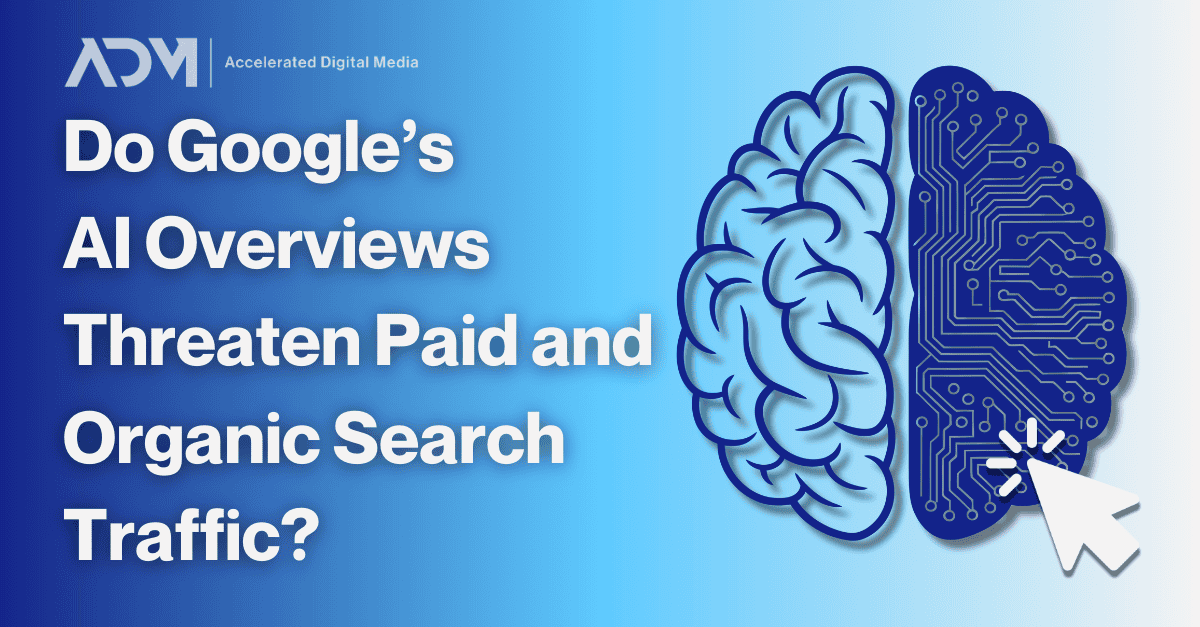Digital marketing for eCommerce is an intricate and interconnected process. It relies on a robust understanding of each brand’s entire digital presence, their product offerings, and their target audiences. An expert eCommerce marketing agency will apply a thoughtful, full-funnel approach to all of their client accounts.
In this blog, we’ll take a look at the key facets of this process, from analytics and attribution setup to choosing key campaigns across different marketing channels and, finally, to building a full-funnel strategy.
Getting Started: Setting Up Analytics and Attribution for eCommerce
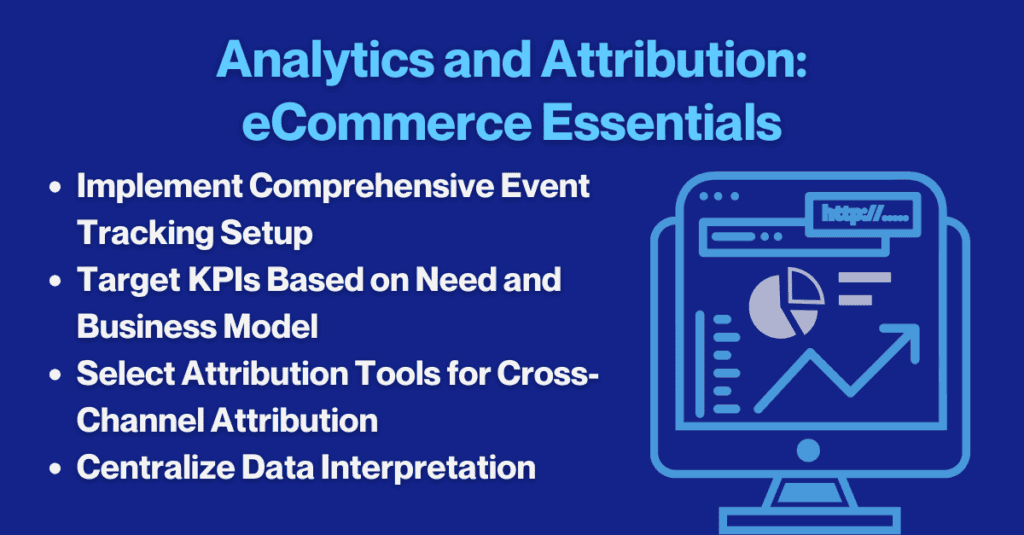
Before any campaigns can be built or ads can be optimized, an eCommerce marketing agency will want to verify that your analytics and measurement capabilities are completely in order. They need to ensure that:
- Your website is set up to track all necessary aspects of your digital marketing strategy, including Google Ads, social media marketing, and programmatic advertising.
- That there are mechanisms in place to turn that data into actionable insights to inform your future decisions.
To do that, they’ll work with you to address several areas of digital marketing analytics implementation, including which KPIs matter most to your brand, what events need to be tracked from your website, what tracking mechanisms you need to have in place, and what analytics and attribution tools are a best fit for your implementation and business goals.
Choosing the Right KPIs for Your eCommerce Goals
Every eCommerce business is different and has different goals. Your marketing agency will help you identify the key performance indicators (KPIs) that are essential for your brand’s success. Important KPIs in eCommerce marketing include:
- Revenue
- ROAS (Return on advertising spend)
- CPA (Cost per acquisition)
- CAC (Customer acquisition cost)
- AOV (Average order value)
- LTV (Lifetime value)
Understanding your business priorities will guide you in selecting the right KPIs and support your eCommerce marketing strategy.
Setting Up Accurate Tracking for Purchases and Other Events
Accurate tracking of purchases and other critical events is vital for effective eCommerce marketing. In the very least, you’ll want to track:
- Main website visits
- collection page visits
- “Add to Cart” actions
- “Initiate Checkout” actions
- Purchase confirmations
With proper setup, you’ll also be able to define more website events that may indicate buyer intent. An expert agency will need to implement or validate your:
- Google Analytics 4 (GA4)
- Google Tag Manager
- Meta Pixels
- Other digital marketing or analytics tags and pixels
To make sure the right events are being captured every time—and not over or under-counted along the way.
Understanding eCommerce Attribution
A well-rounded eCommerce marketing strategy needs to be validated through cross-channel attribution. This is vitally important, because the model you choose will influence the insights you get. Your agency will need to help you find the correct way to look at and interpret marketing performance based on your business needs.
- Multi-Touch Attribution (MTA) assigns credit for conversions across touchpoints using models like Last Click, First Click, Linear, and Rule-Based.
- Marketing Mix Modeling (MMM) combines MTA and Media Mix Modeling to incorporate factors such as click data, post-purchase surveys, incrementality, and geo lift.
- Incrementality uses test-and-control measurement to determine the true lift of media channels without relying on cookies or pixels, providing clearer insights into each channel’s incremental impact.
At ADM, we favor incrementality for its specificity and clarity in understanding each channel’s direct impact on overall marketing efforts.
Once you know how you need to track your conversion data, your agency will help you find a singular “source of truth” for your marketing decisions. Some common third-party attribution platforms include:
- Measured: Focused on incrementality and A/B tests.
- Rockerbox: Emphasizes cross-channel measurement with Multi-Touch analysis and leverages post-purchase survey data.
- Triple Whale: Tailored for Shopify merchants, utilizing MTA and MMM modeling.
- Google Analytics 4: Free option providing cross-channel data but excludes ad spend data outside of Google Ads.
Having a strong attribution implementation allows you to get a holistic picture of your marketing success across all channels so you can make strategic and budgetary decisions with confidence.
Learn More:
- What ADM Looks for During a Google Analytics Audit
- Understanding Attribution Models and Choosing an Attribution Platform
- Getting the Right Data to Power Your eCommerce Marketing
Building a Robust eCommerce SEM Strategy
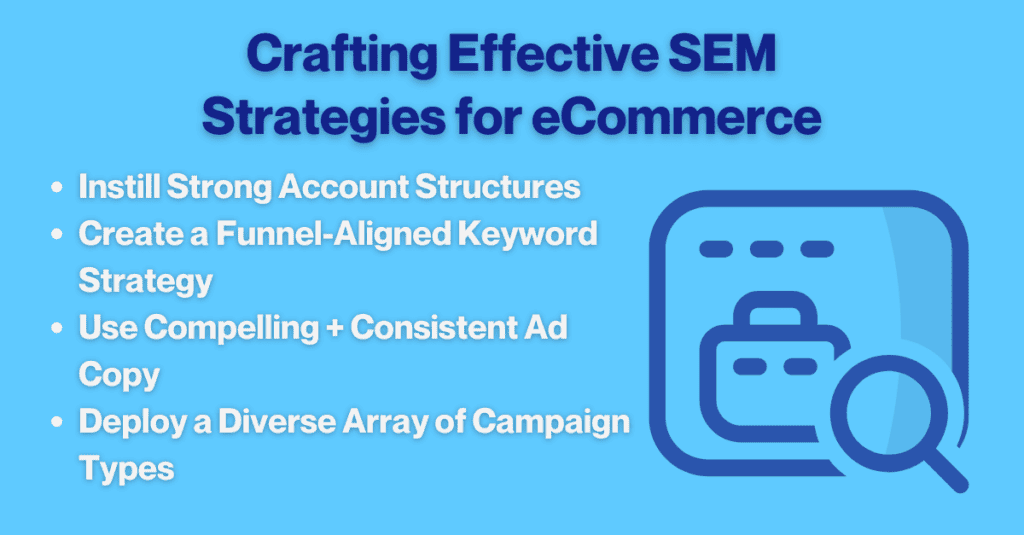
When eCommerce agencies speak of search engine marketing (SEM), they’re mostly focused on Google Ads—because it’s by-far the most-dominant paid search advertising tool. But Google Ads isn’t limited to paid search. It also covers several multi-format campaign types, product listing ads, YouTube Ads, and even other platforms.
In this section, we’ll primarily be looking at how to build a full-funnel eCommerce SEM strategy with Google Ads, including: establishing the foundation for strong Google Ads campaigns, and choosing the right campaign types at each stage of the sales funnel. No matter whether your goal is to.
The Building Blocks of Effective Google Ads Campaigns
In order to get the most out of each unique campaign, a good eCommerce marketing strategy will have high standards for how it manages its Google Ads accounts. An agency should demonstrate that it can provide:
A strong account structure is essential for running unique campaigns targeting different funnel stages, which may involve setting up variations of the same campaign type to address each step of the funnel.
Intentional keyword strategy aligned with the funnel approach is crucial, targeting keywords for the middle, bottom, and post-purchase stages, allowing for precise budget allocation, bidding strategies, and ad messaging.
Varied audience targeting customized to match the funnel stage being addressed is recommended, tailoring strategies for each audience segment.
Focused ad copy and creative elements are necessary components for effective Google Ads eCommerce campaigns.
The Most Important eCommerce Google Ads Campaigns
eCommerce marketing agencies build your strategy from a healthy blend of campaign options:
- Branded Paid Search Campaigns: Paid search campaigns that bid on your brand and products by name.
- Non-Branded Paid Search Campaigns: Paid search campaigns that bid on keywords relevant to your brand and products.
- Video Reach Campaigns: Google’s most versatile video campaign type. It runs across all YouTube ad formats, including in-stream ads, YouTube Shorts, and bumper ads. Other video campaigns include Video View Campaigns and Video Action Campaigns.
- Performance Max Campaigns: Google’s most impressive AI-driven campaign type. It relies on algorithmic insights to serve across Google formats, including search, display, YouTube, and most importantly for eCommerce: product listing ads. For many eCommerce brands, they have rightly replaced standard Shopping campaigns.
- Demand Gen Campaigns: Meant to, well, generate demand—these campaigns operate like Performance Max at the top of the funnel, primarily by serving across multiple YouTube formats.
Incorporating Microsoft Ads
While Google is the dominant player in the SEM space, do not overlook the potential of other advertising platforms like Microsoft Ads. It offers many similar paid search functionalities, often at a lower cost-per-click—which makes it a useful way to supplement existing search strategies with better efficiency.
Learn More:
- Expert Tips for Building Better eCommerce Campaigns with Google Ads
- SEM Tips for Black Friday and Cyber Monday Success
Designing a Multi-Faceted eCommerce Paid Social Strategy
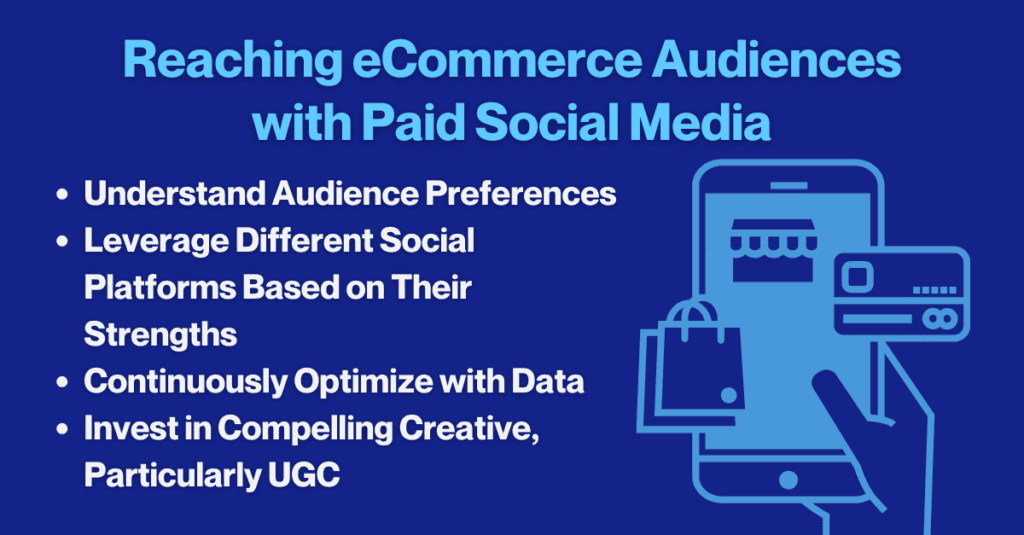
Although paid social advertising isn’t nearly as monopolized by one platform as SEM is, there is still a singular juggernaut: Meta Ads. When many eCommerce marketing agencies pitch their paid social strategies, they’re primarily focused on Meta because it allows their clients to reach users on the most-popular (Facebook) and third-most popular (Instagram) platforms in all of social media.
While Meta Ads is going to be a major component of any paid social strategy, it’s important for eCommerce brands to have a multi-faceted paid social approach. Different platforms—like TikTok, Snapchat, and even LinkedIn—offer different audiences and advertising advantages.
The Building Blocks of Effective eCommerce Marketing on Paid Social
Quality eCommerce marketing agencies might deploy different techniques at times, but they’ll mostly operate off the same set of core philosophies:
Audience-Centric Approach: Focus on understanding your target audience’s preferences and behaviors, crafting content, promotions, and targeting strategies tailored to their needs and interests.
Multi-Platform Diversification: Leverage the unique features, audiences, and ad formats of various social platforms like Meta, TikTok, Pinterest, and LinkedIn to maximize reach and foster a dynamic brand presence.
Data-Driven Optimization: Employ a robust data-driven approach to continuously assess performance, identify trends, and optimize campaigns to align with the ever-changing dynamics of the social landscape and customer behavior.
Creative Excellence: Invest in compelling and innovative creatives that captivate users and convey your brand story, encouraging authentic connection through visuals, ad formats, and narratives that resonate with your target audience. User-generated content (UGC) is an increasingly important creative style that good agencies should be able to help you create.
Key Meta Ads Campaign Types for eCommerce Marketing
Video View Campaigns: Ideal for top-of-funnel engagement, these campaigns use dynamic video content to pique users’ interest in your brand—and can be used to qualify
Traffic Campaigns: Middle-of-funnel campaigns focus on driving traffic to your website, generating interest in your products and services.
Advantage+ Campaigns: Advantage+ is a powerful AI-driven Meta campaign type with some similarities to Google’s Performance Max. Designed to optimize results while requiring fewer targeting inputs, Advantage+ delivers effective outcomes by primarily targeting users with a high likelihood of making purchases. It uses Meta’s advanced machine learning capabilities to help businesses drive conversions and it can be deployed with Dynamic Product Ads, making it particularly beneficial for eCommerce brands.
Other Main Social Media Platforms and Their Advantages
Each social media platform offers distinct benefits for eCommerce marketing:
TikTok: Engages younger audiences with creative, short-form videos, and offers significant reach and influence. Ideal for showcasing trendy content, product demonstrations, and partnering with influencers.
Pinterest: Ideal for product discovery, particularly in fashion and lifestyle categories. Visually appealing content drives traffic and high conversion rates, making it suitable for product-based businesses.
LinkedIn: Targets professionals, offering B2B marketing opportunities for specific industries. Advertisers can engage influencers, create informative content, and foster professional connections.
Snapchat: Attracts younger audience, and uses sponsored filters and lenses to create engaging ad experiences. Ideal for virtual try-ons in fashion and apparel brands, and quick product showcases.
Reddit: Facilitates participation in niche, industry-specific forums and conversations with sponsored posts. Allows brands to tap into highly engaged communities and build trust through peer reviews.
Learn More:
- Expert Tips for Building Better eCommerce Campaigns on Facebook and Instagram
- Tips for Building Better eCommerce Campaigns with TikTok, Pinterest, and X
Use Programmatic Advertising to Boost Your eCommerce Marketing Strategy
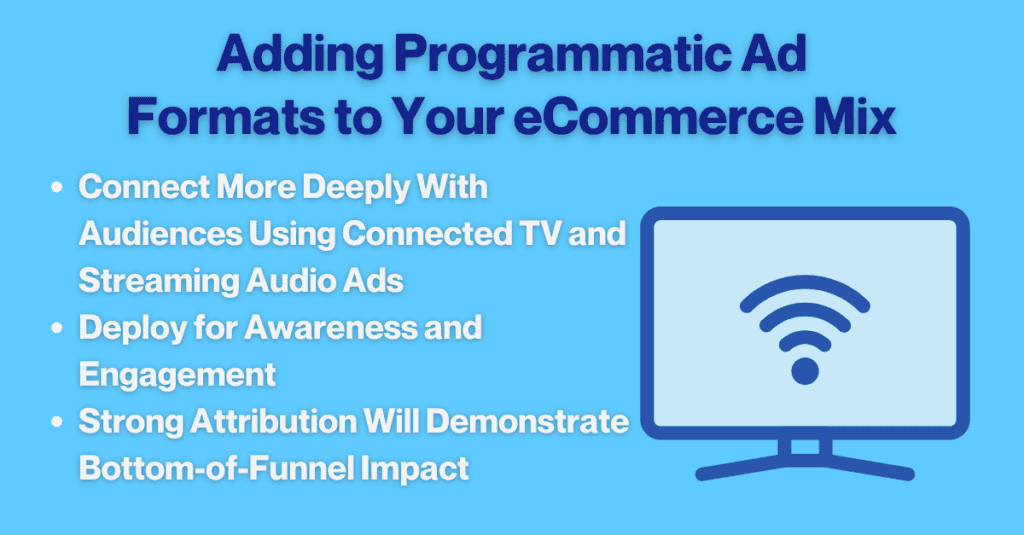
Another thing that the best eCommerce marketing agencies offer? Programmatic advertising. Programmatic covers a host of digital ad properties that aren’t accessible through SEM or paid social: Podcast ads, streaming video ads on connected TV, banner ads on major websites, and more.
While banners, commercials, and streaming audio ads may seem like they’d all be top-of-funnel tactics, that isn’t necessarily the case. And because programmatic ads add digital traceability to traditionally-effective formats (like the TV commercial), they can be integrated with your attribution models and used to complement your other digital marketing channels.
Connected TV
Connected TV advertising allows eCommerce brands to combine the effectiveness of traditional TV ads with the targeting and tracking capabilities of digital marketing. Target well-defined audiences and purchase placements on streaming platforms like Hulu, Peacock, and HBO.
Advantages:
- Enables specific audience targeting
- Offers high engagement rates and non-skippable ads
- Expands inventory for ad placements
- Provides a relaxed environment for brand exposure
- Compatible with programmatic display for sequential messaging
Streaming Audio Ads
Podcast and streaming audio advertising presents a unique opportunity for eCommerce brands to connect with a highly captive and loyal audience. Audio ads are some of the most-trusted ad types in digital marketing. By selecting show genres that align with the brand’s values and resonate with the target audience, these ads can serve as a non-display touchpoint in a multi-channel campaign.
Advantages:
- Reaches captive and loyal audiences
- Aligns with brand values through selected show genres
- Functions as a touchpoint in multi-channel campaigns
- Generates better brand recall than display ads
Programmatic Display Advertising
Programmatic display advertising uses either: contextual targeting to place banner ads on relevant sites or articles related to the eCommerce brand’s products; or audience targeting to reach highly-tailored audience interests or behaviors.
Advantages:
- Offers highly granular targeting options
- Cost-effective compared to paid search and social
- Provides real-time campaign performance monitoring
- Reaches audiences through contextual or behavioral targeting
- Combines with Connected TV for a comprehensive advertising strategy
Learn More:
- Using Programmatic Advertising to Boost eCommerce Success
- How Programmatic Display and Connected TV Advertising Work Together to Level Up Your Marketing
How eCommerce Marketing Agencies Cover the Whole Funnel
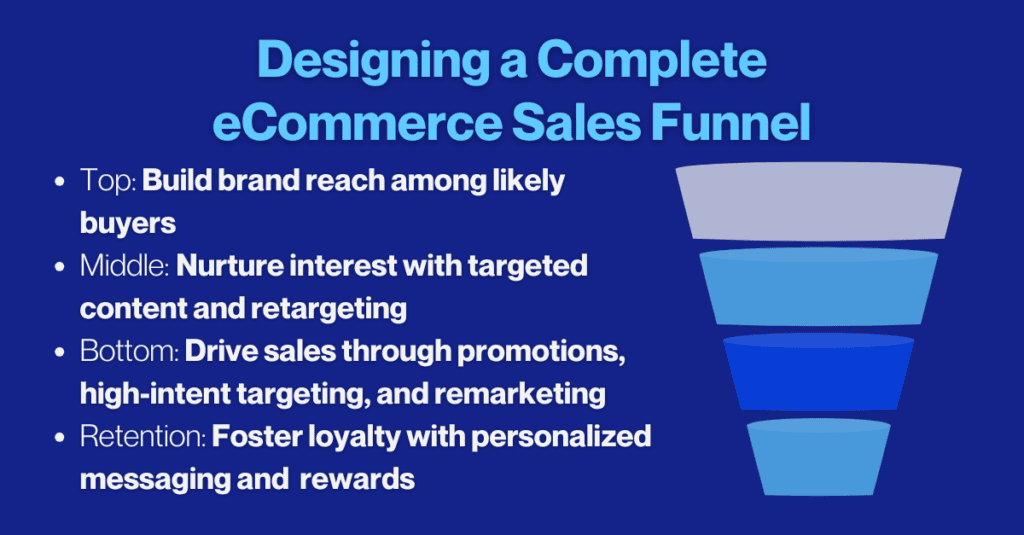
With proper tracking and analytics in place and the full array of digital marketing tools at its disposal, an eCommerce marketing agency can get down to constructing a full-funnel strategy for your brand. Every eCommerce business is different and might need to emphasize different areas of its sales funnel, but for the most part, a good strategy will likely resemble the following.
Top of Funnel (Awareness)
At this stage, the primary goal is to generate brand awareness and reach a broad audience. The tactics used should aim to capture interest and convey the brand story without expecting immediate conversions.
Google Ads:
- Key Campaign Types: Utilize video, display, and demand generation campaigns.
- Targeting: Implement detailed demographic targeting and affinity audiences interested in related topics.
- Creative/Messaging Focus: Craft compelling narratives with unique selling points and eye-catching visuals to stand out.
Social Media Marketing:
- Platforms: Meta (Facebook and Instagram), TikTok, Pinterest.
- Tactics:
- Use video view campaigns on Meta and TikTok for dynamic engagement.
- Leverage broad targeting and visually appealing content on Pinterest for early-stage discovery.
- Partner with influencers on Instagram to amplify brand reach.
Programmatic Advertising:
- Tactics:
- Deploy connected TV ads on platforms like Hulu or HBO for household visibility.
- Use audio ads on podcasts to build authenticity and brand affinity.
- Apply programmatic display ads through contextual targeting for enhanced visibility on high-traffic sites.
Middle of Funnel (Consideration)
The focus here is to nurture interest and influence potential customers to explore your products further. At this stage, it’s essential to address consumer pain points and encourage deeper engagement with your offerings.
Google Ads:
- Key Campaign Types: Search, Performance Max shopping ads, video
- Tactics:
- Use in-market and custom intent audiences, as well as similar audiences and website visitors.
- Highlight product benefits with clear CTAs and address pain points to deepen interest.
Social Media Marketing:
- Platforms: Meta, Pinterest, LinkedIn.
- Tactics:
- Execute retargeting campaigns on Facebook and Instagram to re-engage interested users.
- Implement lead generation and carousel ads on LinkedIn to showcase multiple products.
- Offer incentives to nurture prospects further down the funnel.
Programmatic Advertising:
- Channels: Connected TV, Streaming Audio
- Tactics:
- Utilize data-driven insights to orchestrate display and streaming ads that guide users through their consideration phase.
- Track audience interactions and tailor messages to specific user interests and behaviors.
Bottom of Funnel (Conversion)
At this stage, the aim is to convert prospects to paying customers. The emphasis should be on generating action, reducing friction, and overcoming barriers to purchase.
Google Ads:
- Key Campaign Types: Search, shopping, and remarketing video campaigns.
- Tactics:
- Deploy remarketing lists, customer match lists, and dynamic remarketing to engage those showing high purchase intent.
- Focus on high-intent keywords for search and shopping campaigns
- Promote attractive offers and discounts, and create urgency with time-limited deals.
Social Media Marketing:
- Platforms: Meta, TikTok, Pinterest.
- Tactics:
- Use dynamic product ads on Facebook and Pinterest to encourage immediate purchases
- Feature customer testimonial ads to build credibility and finalize conversions on Meta.
- Utilize TikTok’s engaging format to highlight exclusive promotions.
Programmatic Advertising:
- Implement retargeting strategies targeting past site visitors or cart abandoners using tailored ads across streaming and display channels.
Retention
Retention strategies focus on building long-term relationships with customers by engaging them post-purchase, enhancing brand loyalty, and encouraging repeat purchases.
Google Ads:
- Key Campaign Types: Use display and video remarketing campaigns to re-engage past purchasers.
- Targeting: Employ customer match lists to deliver personalized messaging.
- Creative/Messaging Tips: Offer loyalty rewards, tailor content to past interactions, and suggest complementary products for upsell opportunities.
Social Media Marketing:
- Platforms: Meta, Instagram
- Tactics:
- Promote customer loyalty programs through platforms like Meta.
- Encourage user-generated content on Instagram to build community and brand advocates.
Other Techniques:
- SMS
- Email marketing
Learn More:
- Building a Full-Funnel eCommerce Strategy with Google Ads
- The Budgeting and Management Mistakes to Avoid in Your Paid Social Advertising
- 5 Reasons Why Connected TV Ads Are Key to Top-of-Funnel Success
Choosing the Right eCommerce Marketing Agency
Selecting the right marketing agency is a crucial decision for eCommerce brands looking to scale and succeed—but they have a lot of options. Ultimately, brands should partner with the agency that best understands not only digital marketing but, more importantly, their unique business needs and goals.
Assess the agency’s approach to data-driven strategies, commitment to continuous optimization, experience in managing campaigns with optimal budget allocation across the marketing funnel, and overall ability to adapt and stay ahead of changes in the dynamic digital marketing landscape. The right agency will employ most or all of the techniques outlined above and be willing to construct custom solutions for clients as needed.
If you’re on the hunt for excellent digital marketing services, or are looking for an outside agency to audit your current approaches, don’t hesitate to reach out to the ADM team today:


